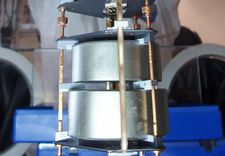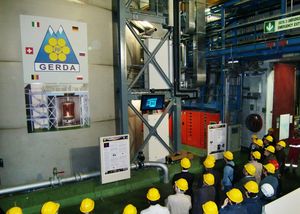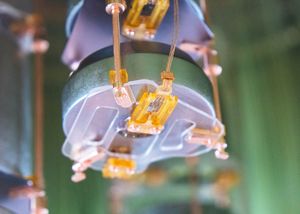Are neutrinos their own antiparticles? The future LEGEND experiment will enable scientists to learn more about this propertie of neutrino, also called "Majorana nature". LEGEND was formed as a follow-up to the previous GERDA and Majorana experiments.
Current insights suggest that for every charged spin-1/2 particle there exists an antiparticle with an opposite electric charge: anti-quarks and anti-leptons (positron, anti-muon, and anti-tau). As the corresponding neutrinos are electrically neutral, they may differ from this scheme and be their own antiparticle. If this was confirmed experimentally, it could open up new ways to improve our understanding of the physics of the universe.
How, then, can scientists discover if neutrinos are their own antiparticles?
They can search for a very special type of decay that only occurs if this is the case: neutrinoless double beta decay, in which two neutrons are converted into two protons and two electrons. In standard double beta decay, two neutrinos are also released. In neutrinoless decay, however, these are exchanged within the nucleus. But this can only occur if
- neutrinos and their antineutrinos are identical, and
- they have the same mass.

In order to detect neutrinoless double beta decay, the LEGEND experiment will use detectors made of germanium-76, an unusual element that is, at least theoretically, capable of producing this decay. If the experiment can detect such decays, the presumed “dual nature” of the neutrino will be confirmed. Such detection relies on the fact that germanium-76 is not only the source of the decay, but also the material used to detect it.
In the first phase, the participating research groups will conduct the LEGEND 200 experiment at the LNGS using 200 kilograms of detector material. The experiment is scheduled to begin collecting data in 2022. In the second phase, an experiment employing 1000 kilograms of germanium detector material will be constructed. Both the location and time-line of the experiment are still under discussion.
Even if neutrinoless double beta decay does exist, it is an extremely rare phenomenon. It could never be detected in the presence of normal natural radiation, as this produces background events similar to signal events.
For this reason, experiments searching for neutrinoless double beta decay need to be extremely well shielded from environmental radiation. However, background events also occur due to the radioactivity of the materials used in the experiment itself and due to cosmic rays able to pass through solid objects.
To minimize the influence of cosmic rays, scientists conduct the experiments very deep underground. LEGEND 200 will therefore be assembled at the Gran Sasso underground laboratory in Italy, shielded by 1.4 kilometers of mountain rock against cosmic rays from space.
LEGEND 200 will largely use the infrastructure of the successful GERDA experiment, which achieved the lowest ever background radiation rate. The germanium detectors are placed in a container made of specialized steel that emits very low levels of radiation, and it is filled with liquid argon. This container is embedded in a ten-meter diameter tank filled with high-purity water, providing additional shielding. Moreover, the experiment will also detect muons with specialized detectors to rule out signals that might be caused by these particles.
Research for LEGEND
LEGEND involves more than 30 research institutions from nearly 10 countries. The group at the Max Planck Institute for Physics is working on optimizing the germanium detectors (GeDET). The group is also involved in further subprojects, such as MINIDEX, which studies neutrons as a potential source of disturbances, and PEN, which is developing and implementing new types of optically active components made of plastic, which are already being installed in LEGEND 200.
GeDet is committed to to further develop and optimize germanium detector technology. The goal is to design improved detectors in which background can be better identified. (Photo: I. Abt/MPP)
Neutrons are a source for background events difficult to detect. The goal of the MINIDEX project is to study cosmic-muon-induced neutrons which cause an especially dangerous background. (Photo: I. Abt/MPP)
The goal of the PEN project is to provide an active veto against radioactive background and at the same time wrap and protect the germanium detectors. (Photo: F. Fischer/MPP)
LEGEND at the MPP

Final results and completion of the GERDA experiment
The search for neutrinoless double-beta decay continues with new LEGEND experiment
Phone number: +49 89 32354-extension
| name | function | extension | office | |
|---|---|---|---|---|
| Butorev, Arthur | Student | arthur.butorev | 295 | A.2.53 |
| Caldwell, Allen, Prof. Dr. | Director | allen.caldwell | 529 | A.2.51 |
| Gooch, Christopher | Engineering | christopher.gooch | 242 | A.1.63 |
| Hagemann, Felix, Dr. | Postdoc | felix.hagemann | 295 | A.2.57 |
| Hildebrandt, Richard | Student | richard.hildebrandt | 554 | A.2.53 |
| Krüger, Sophia | Intern | sophia.kruger | 327 | A.2.69 |
| Liu, Xiang, Ph.D. | Senior Scientist | xiang.liu | 415 | A.1.65 |
| Majorovits, Béla, PD Dr. | Senior Scientist | bela.majorovits | 262 | A.2.71 |
| Nagler, Benedikt | Student | benedikt.nagler | 554 | A.2.53 |
| Pearson, Ariana Monique | Intern | ariana.pearson | 295 | A.2.57 |
| Schulz, Oliver, Dr. | Senior Scientist | oliver.schulz | 521 | A.2.61 |
| Wacker, Ina | Secretary | ina.wacker | 207 | A.2.49 |
| Zhang, Peng | Visiting Scientist | peng.zhang | 327 | A.2.69 |
| Álvarez García, Claudia, Dr. | Postdoc | claudia.alvarez | 337 | A.2.73 |
Alpha-event and surface characterisation in segmented true-coaxial HPGe detectors
Nucl. Instrum. Meth. A 858 (2017) 80-89
The GALATEA test-facility for high purity germanium detectors
Nucl.Instrum.Meth. A 782 (2015) 56
Measurement of the temperature dependence of pulse lengths in an n-type germanium detector
Eur. Phys. J. Appl. Phys. 56 (2011) 10104
Pulse shape simulation for segmented true-coaxial HPGe detectors
Eur. Phys. J. C 68, 609-618 (2010)
Neutron Interactions as Seen by A Segmented Germanium Detector
Eur. Phys. J. A 36, 139-149 (2008)
Characterization of the first true coaxial 18-fold segmented n-type prototype detector for the GERDA project Nucl.Instrum.Meth. A 577 (2007) 574


![[Translate to English:] GeDet-Germaniumdetektor [Translate to English:] GeDet-Germaniumdetektor](/fileadmin/_processed_/9/2/csm_fm3e3F4.7x5_fb0c3cd3b1.jpeg)

![[Translate to English:] Eine von UV-Licht angeregte PEN-Kachel [Translate to English:] Eine von UV-Licht angeregte PEN-Kachel](/fileadmin/_processed_/5/0/csm_PEN-UV-1600x900-7x5_f6fecd1472.jpeg)
